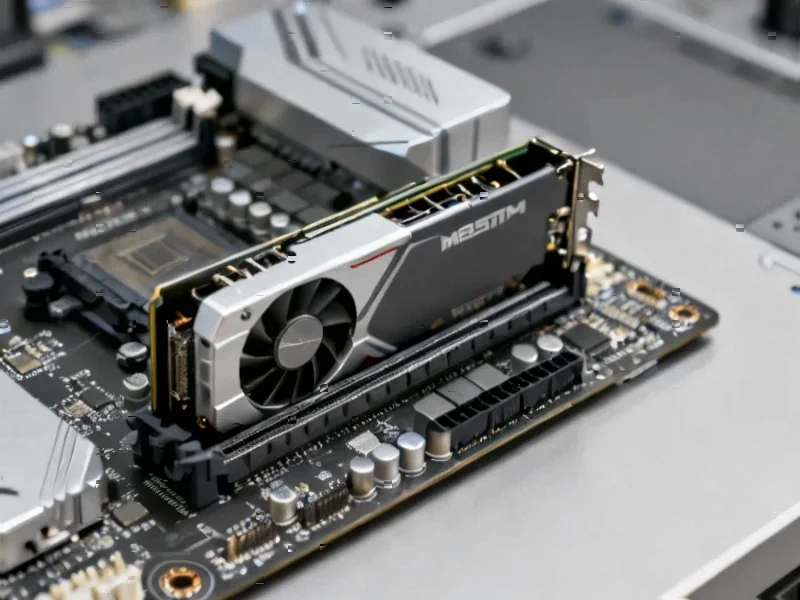According to Guru3D.com, another case of a burned 12V-2×6 power connector has been reported, this time affecting a Sapphire Radeon RX 9070 XT graphics card during regular gaming sessions. The issue, documented by Reddit user u/ProfessionalHost3913, shows severe connector scorching despite the card running at stock settings without overclocking. The failure occurred while playing Battlefield 6, Cyberpunk 2077, Outerworlds, and Minecraft, with the problem traced to using a 3×8-pin adapter instead of a native 12V-2×6 cable. This incident follows similar 12V-2×6 failure reports since mid-2025, demonstrating that even the revised connector design remains vulnerable when paired with non-native power supplies. The situation reveals deeper industry challenges that demand examination.
The Cost of Backward Compatibility
The recurring power connector failures represent a fundamental business model conflict in the PC component industry. GPU manufacturers face pressure to deliver cutting-edge performance while maintaining compatibility with existing power supplies, creating a dangerous middle ground. The adapter solution essentially serves as a cost-saving measure for both manufacturers and consumers, but the financial consequences of these failures likely exceed any initial savings. When a $900 graphics card fails due to a $15 adapter, the warranty claims, customer service overhead, and brand damage create a negative return that manufacturers haven’t adequately calculated. The industry’s approach to this problem reflects a classic case of distributed responsibility where no single party bears full accountability for system integration failures.
Market Fragmentation and Consumer Confusion
The power connector issue highlights how market fragmentation creates consumer confusion with expensive consequences. With multiple standards coexisting—ATX 2.x, ATX 3.0, ATX 3.1—and various connector types (12VHPWR, 12V-2×6, traditional 8-pin), consumers face a compatibility minefield. This complexity benefits component manufacturers by driving upgrade cycles but damages the overall ecosystem when failures occur. The situation described in the Reddit documentation shows how even informed enthusiasts can fall victim to these compatibility gaps. From a business perspective, this fragmentation represents both an opportunity and a threat—upselling consumers to newer PSU standards generates revenue, but systemic failures risk damaging brand trust across multiple product categories.
Warranty and Liability Implications
These recurring connector failures create significant warranty and liability challenges that could reshape industry practices. When a GPU fails due to what manufacturers might classify as “user error” in cable selection, the resulting disputes over warranty coverage create customer relations nightmares. The financial impact extends beyond replacement costs to include shipping, handling, and the operational burden of determining fault. More concerning is the potential for property damage beyond the GPU itself—imagine a connector failure causing broader system damage or even fire hazards. This liability landscape may eventually force manufacturers to either bundle certified power adapters with high-end GPUs or implement more aggressive compatibility warnings, both of which would increase product costs.
Strategic Opportunities in Crisis
Despite the negative implications, this ongoing issue creates strategic opportunities for forward-thinking companies. Power supply manufacturers who can deliver reliable ATX 3.1 solutions with clear compatibility messaging stand to gain significant market share. We’re already seeing companies like Seasonic and Corsair positioning their newer PSU lines as “GPU-safe” solutions, creating a premium tier in the power supply market. Meanwhile, third-party cable manufacturers like CableMod have built entire businesses around aftermarket solutions for these exact problems. The connector issues essentially create a new market segment focused on power delivery reliability, representing what could become a $500 million annual opportunity for companies that solve these problems effectively.
Long-Term Industry Shifts
The persistent power connector problems signal needed evolution in how the PC industry approaches power delivery standards. The current situation—where GPU power demands increase 40-60% per generation while connector technology evolves more slowly—is fundamentally unsustainable. We’re likely approaching a tipping point where either manufacturers will need to standardize on more robust connector designs years in advance or move toward integrated power solutions that reduce consumer-facing complexity. The business case for pre-emptive standardization is strengthening as the costs of these failures mount. What began as technical compatibility issues are evolving into strategic business decisions that will shape the next decade of PC component design and compatibility.




